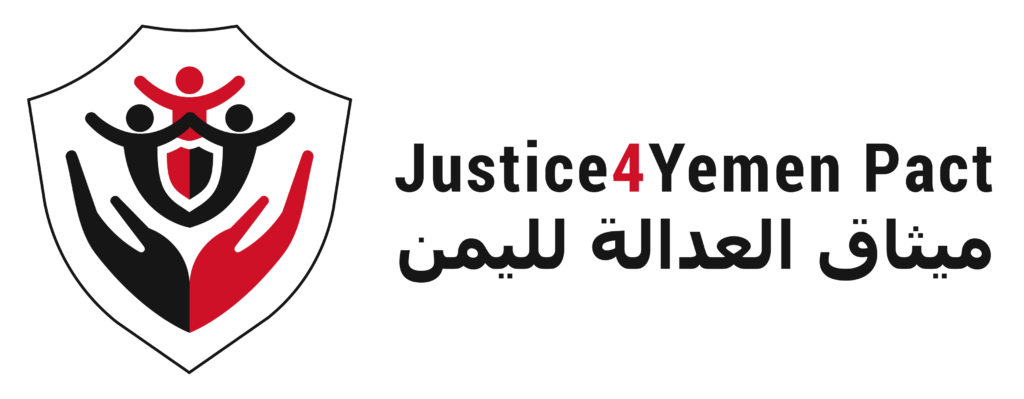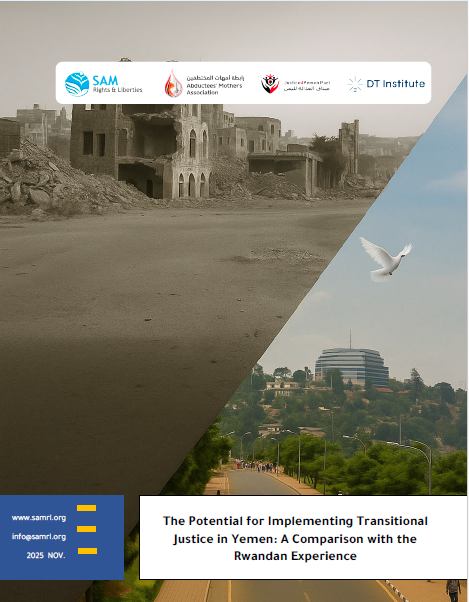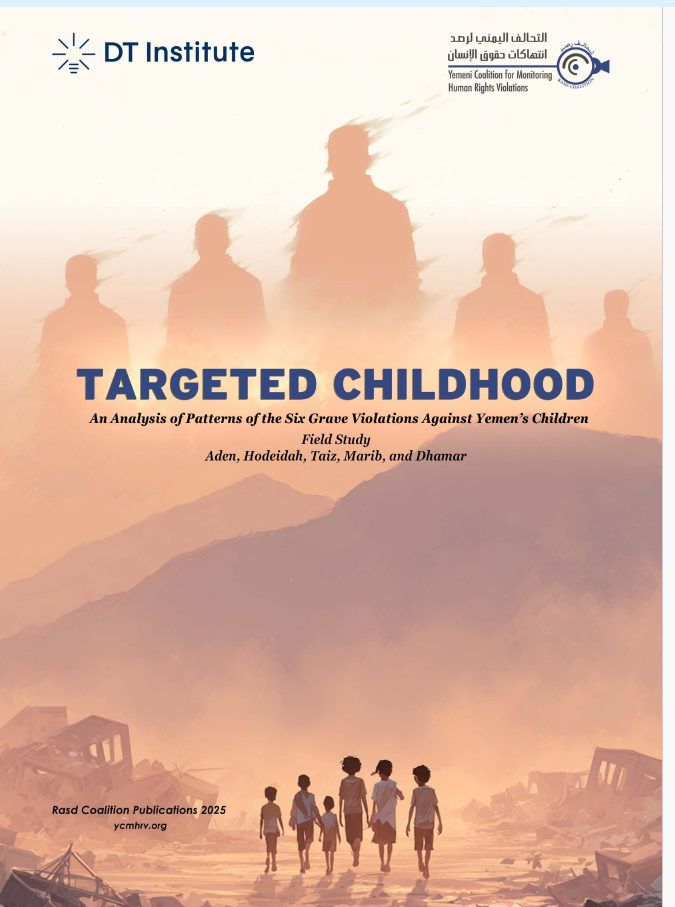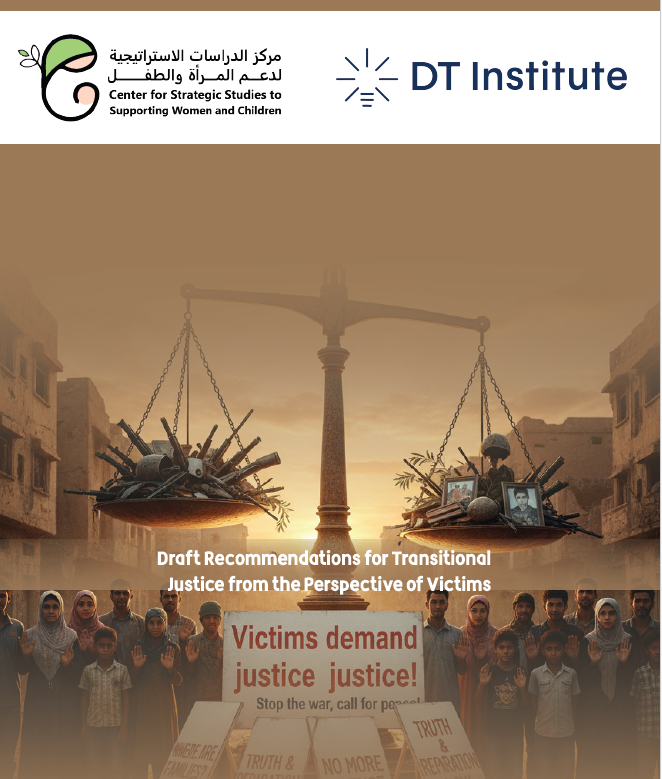1. Overview of the SPARK Program
In July 2025, the SPARK team, composed of DT Institute and its local partners, the Abductees’ Mothers Association (AMA) and SAM for Rights and Liberties (“SAM”), launched the first restorative justice (RJ) pilot initiatives in Taiz. These initiatives aim to foster reconciliation and resolve community-level public disputes that have caused human rights violations.
The RJ model was designed in response to the findings of The Path Towards Peace, a research study published by SPARK in April 2025. This study captured local understandings of transitional justice (TJ) across Yemen, revealing that 64.3 percent of community members prioritize reconciliation and war-ending efforts over retributive accountability. Participants identified clear roles for civil society: initiating dialogue and reconciliation, offering legal and financial aid to victims, raising TJ awareness, and documenting violations.
2. Initiative Spotlight: The Tanker Massacre Initiative
The SPARK team has already resolved one of the first initiatives under this program, the Tanker Massacre Initiative.
This initiative addressed the deep and painful legacy of the tanker massacre – one of the most tragic incidents involving mass causalities that occurred during the siege of Taiz in 2015. At this time, the Houthi (Ansar Allah) forces captured key parts of the city amid intense armed conflict with local authorities and other conflict parties involved in Yemen’s war. Due to the gross negligence of both the local authorities and the Houthis (in maintaining the blockade), an oil tanker caught fire. The fire spread, causing over 150 casualties, including children and civilians, and leading to widespread devastation.
The pain of the community has only deepened in the 10 years since the incident. Many of the victims’ bodies were not recovered after the fire due to governmental negligence and the raging conflict, which also prevented authorities from adequately addressing the incident. Some victims had their bodies incinerated by the fire or burned beyond recognition. The tragedy remains unacknowledged, leaving victims’ families and community members trapped within their grief and loss, unable to move on without proper accountability in place.
3. Agreement and Impact
Ten years from the occurrence of the siege and tanker massacre, the atrocity and its victims are finally being acknowledged. A comprehensive record of all victims is being complied – preserving the memory of the victim and the human rights violations they endured. Survivors, family members, and local activists, under the SPARK-created Taiz Siege Committee, are leading efforts to formally and permanently memorialize the victims and the atrocity – symbolically, physically, and as evidence of human rights violations.
To create the comprehensive record of victims, SAM is collecting testimonies, extracting death certificates (many of which were never issued due to the incineration of the victims’ bodies in the fire), and analyzing all available data. To date, SAM has identified 111 victims, documented 71 human rights violations related to the massacre, and collected 40 death certificates. SAM also coordinated with the Civil Status Department to issue seven death certificates for those missing documents.
Simultaneously, the Taiz Siege Committee is leading initiative activities – engaging with local authorities, directing efforts for the reopening of the National Museum in Taiz under the Memory Museum project and the building of a memorial on the site of the massacre, and relaying the will of the broader community and other victims.
In doing so, the Committee met with SAM, the CRCC, and local government representatives in over three key meetings. Representatives included the director of the district of Al-Mudhaffar, the Taiz Governor’s Deputy for Defense and Security Affairs, Director of the Civil Status and Civil Registry Department, Director of the Care Foundation, and the Undersecretary of the Ministry of Interior.
In the meetings, SPARK representatives garnered the local authorities’ support and discussed implementation of memorialization and documentation activities, including collection of victims’ records. In the meeting with the Undersecretary, SPARK representatives pushed for formal recognition of the victims and for their inclusion in the national war victim’s registry. As a result, the Undersecretary committed to presenting the comprehensive record of massacre victims to the Prime Minister.
In addition to these meetings, the SPARK team also organized a listening session, attended by 20 participants from the Siege Committee as well as representatives from the local authority. The session enabled the victims to have their voices heard by local authorities and to shed light on the ongoing impact of the massacre on the victims and their families. The session also drew local attention with coverage from Aden Al Ghad news outlet.
The session further focused on identifying the victims’ specific demands, highlighting the challenges in accessing reparations and justice, and clarifying the local authorities’ responsibility in addressing similar human rights violations and public disputes in the future. The primary demands centered on financial and medical reparations, official recognition, and the establishment of a memorial to honor the victims. Local authority representatives demonstrated cooperation and will share the demands with relevant government actors once documentation is complete.
The CRCC also sought public recognition for the victims by participating in an event, organized by victims, to commemorate the 10th anniversary of the tanker massacre, on May 25, 2025. At the event, the CRCC gave an address expressing solidarity with the victims’ family and community and emphasizing their steadfast commitment to obtaining justice through this initiative.
In preparation for the event, SAM had a larger banner, displaying the faces of the victims, made. The banner served as a visual reminder of the lives lost, emphasizing the extent of the tragedy and strengthening the community’s calls for nonrecurrence.
To support recovery and healing, SAM organized six psychosocial support sessions for 55 massacre victims and impacted community members, including 28 women and 27 men. Within these sessions, the SPARK team provided a communal and sacred space for grief, healing, and emotional release. The sessions provided highly effective in addressing trauma with multiple participants requesting continued support.
💬 “We used to think that it is not right for a person to talk about his pain and sorrows, and that silence is better. But today, we learned from you that we must talk and let out what is in our hearts in order to feel at ease.” – psychological support session participant
The SPARK team also provided limited legal awareness and knowledge building activities surrounding transitional justice and reconciliation in two sessions so as not to overwhelm the grieving participants. Seven individual consultations were also provided to strengthen the victims’ individual understandings of legal protections and rights guaranteed under both national and international law as relevant to the victim’s experiences and the violation experienced.
💬 “May God reward you good, we benefited a lot from your words today. I am hoping that you can help my brother get out of his situation.” – Nawal, psychological and legal support session participant
4. Learning, Documentation, and Replication
Through implementation of preservation and memorialization activities, SPARK and the Taiz Siege Committee effectively advocated for non-repetition of similar incidents – by revealing the truth of the massacre to the public, documenting a collective narrative, and ensuring this memory is publicly acknowledged and preserved.
The Committee’s inclusion in the planning and implementation of such activities fostered community ownership of the initiative, which was built upon significantly by the greater community’s strong participation in the creation of museum artworks, implementation of museum exhibits and events, and online engagement. This enables future duplication and recreation of the initiatives’ activities, tailored to the local context and local community needs to address other atrocities.
💬 The museum is “a gateway into pain and resilience, preserving victims’ memory as part of reparations and civic awareness.” – Moa’th Al-Faqeeh, SAM project officer
The Memory Museum
To bring awareness to this tragedy and similar human rights violations that occurred during the siege of Taiz, the SPARK team reopened the National Museum in Taiz, which has been closed since the start of the conflict in 2015. The SPARK team initiated this process by meeting with the Office of Siege Affairs in Taiz. From there, three Memorandums of Understanding (MOUs) were signed with the Office of Siege Affairs, the General Authority for Museums and Antiquities, and the Culture Office in Taiz Governorate.
These agreements laid the groundwork for collaborative efforts to document and visually portray the devastation caused by the years-long siege on Taiz. In coordination with these three entities (representing the local authorities in Taiz), the SPARK team launched the Memory Museum in the National Museum on September 6, 2025. To ensure the Museum stood as a true representation of both Taiz’s past and current victims as the legacies of the siege live on, SAM embraced the community and the Committee’s direction and support in gathering items for display.
The community response was astounding as community members gathered to support the initiative. This included 38 local volunteers (including six former SPARK transitional justice trainees) and over 10 illustrators, who reached out to SAM upon hearing about the initiative eager to participate. These artists highlighted the power of storytelling to translating suffering into civic engagement. For example, Nada Mahmoud painted Cairo Castle as a symbol of resilience and depicted struggles with water, electricity, and blocked roads, showing the lived reality of residents.
In response to directives from local authorities, partnerships were extended to academic institutions — including the College of Fine Arts, the Faculty of Arts, and the Education Office — enabling the participation of seven public schools and university students. The SPARK team conducted meetings and further coordination with these schools, providing drawing materials to students for the development of artworks, including paintings and sculptures, expressing the students’ view of the siege.
The SPARK team selected over 165 photographs (including rare images of the ranker massacre and the water crisis caused by the siege), 20 statues, and over 273 pieces of art. The Museum also included an exhibition hall (with a display screen displaying videos related to the siege), a dedicated memory corner, live painting department, and seminar and event area.
Moreover, the Museum was divided into over 10 sections, including those dedicated to live paintings, cartoon depictions, music, photographs, drawings and live story-telling. Exhibits for specific human rights violations, including the Oil Tanker Massacre and violations involving projectiles and explosive objects, were also on display. Each exhibit worked to create a comprehensive record of the decade-long humanitarian tragedy, transforming individual and collective pain into a tangible, collective community memory.
The live painting section was presented by the Neama Rasam and Hayel Complex Schools, which aimed to engage young people in therapeutic participation acknowledging the atrocities. School-age children eagerly engaged with this section and the broader Museum, and SAM team members reported them “like a beehive, roaming the Museum,” emphasizing that most young people visited the Museum more than one.
The opening was a lively event with strong engagement and attendance from diverse segments of the community. Attendance included victims, community members, officials, cultural figures, religious leaders, and representatives from civil society and various political parties, including the Islah, Congress, and Socialist parties. More than ten Local Executive Governorate Offices were also in attendance.
The Deputy Governor for Social Affairs praised it’s vital role in documenting the crimes of the Houthi-imposed siege and the suffering endured by the city’s residents. He noted that the museum embodies the steadfastness and sacrifices of the people of Taiz. He further directed that the Museum’s artworks and models be preserved as a living testimony of the siege. He also suggested exploring the possibility of converting part of the museum into a cultural palace to document the city’s broader history and struggle. The Director of Siege Affairs was also in attendance and praised the Museum’s value to the community.
💬 The museum is “more than documentation – it is a warning to future generations, showing the human cost of war and violations against civilians.” – Maher Al-Absi, Director of the Office of Siege Affairs
The Delegation of the European Union to Yemen (EEAS) also attended the opening. Joost Mohlmann, Head of Development Cooperation of the EEAS described the Museum as “an important initiative that sheds light on the stories of victims and documents violations in a creative and human way.” He noted that the artistic and human documentation was “remarkable work that reflects that will to live despite the siege and harsh conditions…each piece carries a message and a hope for the possibility of rising again.”
The Museum will stand as a deeply-needed reminder – memory cannot be erased.
The exhibitions document the decade of Houthi-imposed siege on Taiz, preserving the collective memory of the city’s suffering and resilience. Within the first week of its opening, the museum attracted more than 2,900 visitors. Among 203 respondents who shared feedback, 171 rated the museum as “excellent,” reflecting its strong resonance with the public.
Since its launch, the Museum remained open for five days. During this time, over 2,000 copies of brochures were distributed to illustrate the human and economic toll of the siege. Several musical performances and listening sessions, hosted by locals, were also held within the Museum, creating an interactive space to strengthen peacebuilding dialogue and attracting more visitors.
These included two sessions on violations against journalists, emphasizing their importance to transitional justice processes in documenting and publicizing the truth of the siege. An additional listening session was held to document live testimonies of violations related to the siege, further preserving collective memory and providing for community healing.
The broad participation from local authorities and officials; prominent social, cultural, and religious figures; journalists; human rights advocates; and civil society representatives – highlights a shared commitment across different sectors to preserve victims’ memories and prevent historical distortion.
💬 “The exhibition captures tragedy with eloquence beyond words, ensuring that memory becomes a tool for justice and reconciliation.” – Asma’a Al-Ra’i, Executive Director of the Abductees’ Mothers Association
💬 “Thank you for this very important exhibition. It shows us the grief, all the touching stories, but also hope for the people of Taiz. We wish you many visitors and we hope to be back one day! – Joost Mohlmann (Head of Development and Cooperation, Delegation of the European Union to Yemen
News Coverage
Due to high public interest and wide coverage — especially by digital content creators — SAM launched a competition for the best short video “reel,” encouraging broader online documentation and outreach of the museum’s message. In closing the Museum, a ceremony was held for participating students and youth. The students were honored, recognizing artistic and photographic works that truly reflected the profound impact of the siege.
To expand coverage of the initiative and further contribute to public awareness and truth telling, a writer has been contracted to publish a report, documenting the massacre, sharing the demands of the victims, and highlighting SAM’s role in advancing transitional justice. The report shares the findings of SAM’s documentation efforts, including the total number of victims (113, including 71 wounded and 42 deaths) for the first time.
The report further analyzes the atrocity itself – piecing together the unfolding of the massacre and direct and indirect responsibility for the incident. In doing so, the report importantly places blame onto the local authorities and the conditions of war unleashed upon Taiz by the Houthi (Ansar Allah) forces. It notes the insignificant and unserious attention the atrocity received from state institutions affiliated with the internationally recognized government of Yemen, including local authorities and the judiciary.
The event attracted broad media coverage from more than 80 local, regional, and international news outlets. These included Belqees, Yemen Shabab, Yemen Today, Al Hadath, and, notably, Al Jazeera, reaching over 100,000 viewers online, and 2,000 brochures were distributed to illustrate the human and economic cost of the siege.
💬 The Memory Museum is a “living archive that safeguards Taiz’s history for future generations.” – Sam Al-Buhairi, local Yemeni journalist
Massacre Memorial
Simultaneously, the SPARK team coordinated with the Labor Office to secure approval for a memorial. The statute was designed and enacted, with consultation from the Taiz Siege Committee, by an engineer, contracted by the SPARK team.
The memorial was installed at the city’s western entrance – a prominent location – as an everlasting memory of the atrocity and of the hope for a more peaceful future.
5. Scaling the Impact
Public unrest and discontent stemming from conflict parties’ continued impunity and indifference towards historical human rights violations is rampant throughout Yemen. Many Yemenis find themselves victims of grave crimes, including violations like the tanker massacre wherein death certificates are largely unavailable, and numerous bodies have remained unburied. In the face of the failure of the legal justice system, Yemenis need actionable and current solutions.
The urgent need for additional RJ pilots is clear: these initiatives play a critical role in easing local unrest, bridging social divides, and laying the groundwork for sustainable peace. Equally urgent is the broader need for transitional justice . After more than a decade of failed national peace talks, victim-centered approaches like restorative justice pilots represent a new path forward.
By demonstrating reconciliation at the community level, restorative justice initiatives operationalize transitional justice principles, educating stakeholders, building trust, and fostering shared frameworks for conflict resolution. These pilots serve as blueprints for future transitional justice efforts, rooted in local ownership, dignity, and dialogue.
The Tanker Massacre Initiative is more than a local success — it is a blueprint for Yemen’s future of restorative justice. By proving that victims can lead their own committees, that victims long gone can at least be named and documented, and that memory can be preserved through institutions like the Memory Museum, the initiative has built tools that Yemen is calling for at the national level.
💬 “This case presented some significant challenges, including procuring victims’ birth certificates and enabling coordination and dialogue with the local authorities. However, these challenges were overcome with the support and expertise of the SPARK team demonstrating the power of empowering victims and community members with such tools and expertise.” – Lynn Arbid, DT Institute’s Program Officer.
These approaches are not confined to Taiz; they can be replicated in every governorate scarred by airstrikes, blockades, shelling, and massacres over the past decade.
💬 “In a country scarred by years of conflict, remembering the victims is not only an act of justice but a way to reclaim our shared humanity. Through the Tanker Massacre Initiative, we seek to memorialize the victims of the oil massacre in Taiz — to ensure their pain is neither forgotten nor politicized. Expanding such efforts across Yemen is crucial to building a truly victim-centered path toward transitional justice — one that resists selective or externally imposed reconciliation, and instead grows from the voices, memories, and resilience of Yemenis themselves.” – Sahar Mohammed, DT Institute Program Assistant





